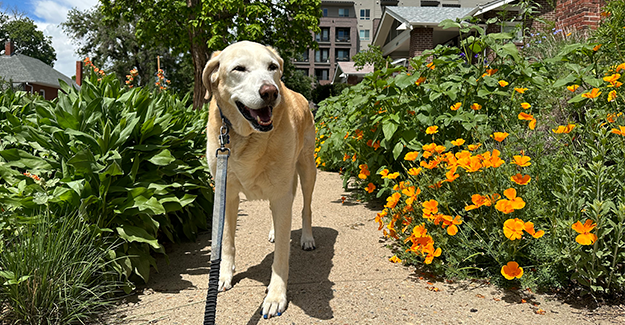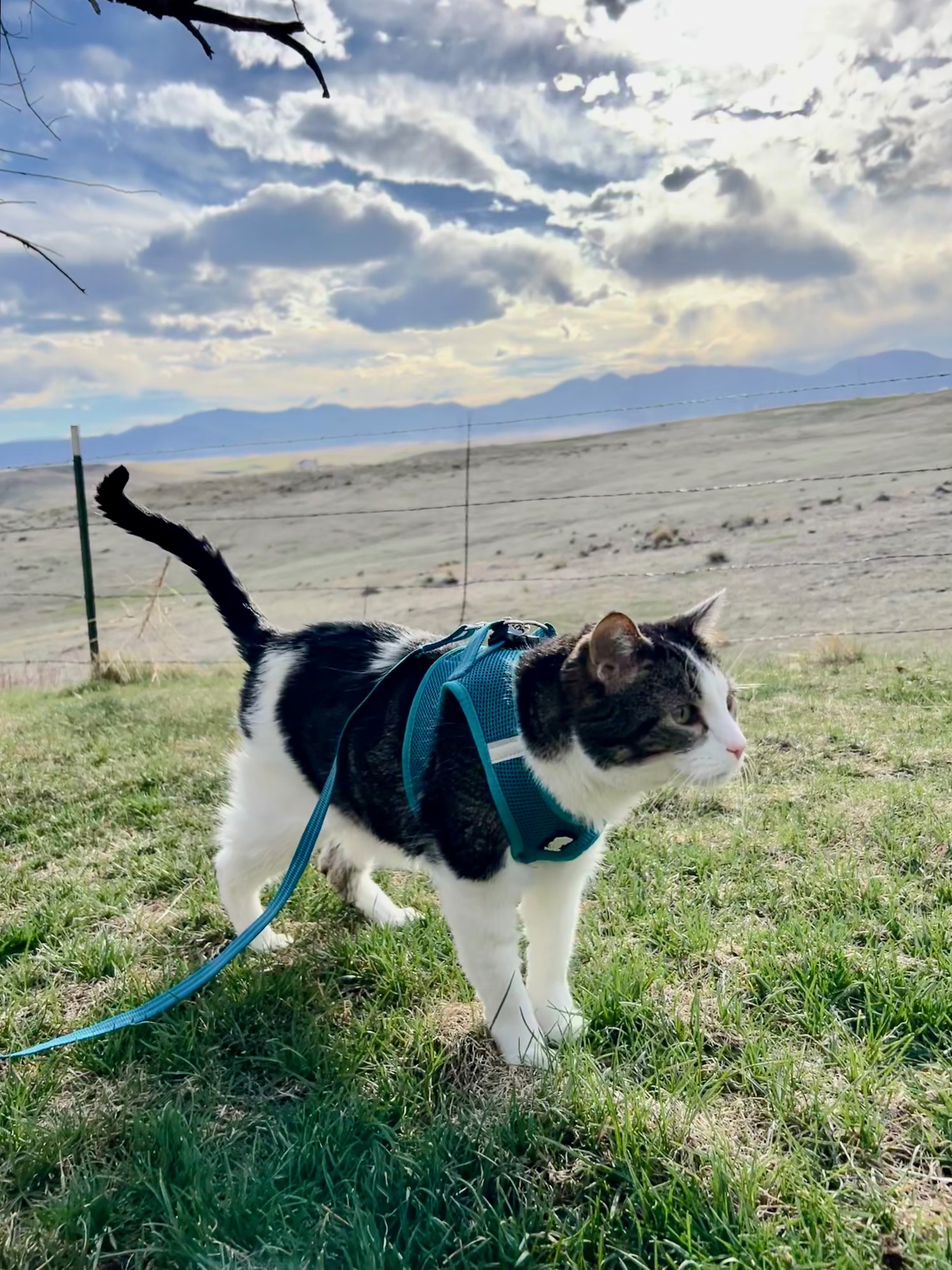Help clients start 2024 on the right foot with Walk Your Pet Month

Senior dogs can enjoy slower sniffy walks. Photo credit: Jen Reeder
January marks a new year as well as Walk Your Pet Month, so there’s no time like the present to talk to animal lovers about setting manageable exercise goals for their pets.
In fact, it’s always a good time for veterinarians to talk to clients about exercise and weight management, according to Martha G. Cline, DVM, DACVIM (Nutrition), veterinary communications manager at Nestlé Purina PetCare, veterinarian at AAHA-accredited Red Bank Veterinary Hospital in Tinton Falls, New Jersey, and chair of the task force that created the 2021 AAHA Nutrition and Weight-Loss Management Guidelines for Dogs and Cats.
She said walking with pets—particularly dogs—is a terrific activity for numerous reasons, including health and bonding.
“Walking with your dog is great for the human-animal bond,” she said. “So I think the main thing is to set realistic expectations in terms of what the goals are for exercise.”
Those goals will depend on a pet’s size, age, and mobility issues (as well as weather conditions), so exercise plans should be customized to the individual dog.
For instance, Cline’s English pointer, Dave, landed in a shelter as a 1-year-old due to his high energy levels. After she adopted him, they started running together—a daily activity they’ve enjoyed for the past seven years.
In contrast, people whose dogs lead sedentary lifestyles might need to slowly work up to adding an extra 20 minutes to their short walks.
If a pet has mobility issues due to weight, a referral to a physical therapist with land-based or underwater treadmill services might be in order, since the workouts can offer better weight loss outcomes than diet change alone.
Healthy weight and longevity
One compelling reason to urge clients to keep their pets at a healthy weight is that research shows they’ll live longer. For instance, a major retrospective study of over 50,000 dogs and 12 breeds titled “Association between life span and body condition in neutered client-owned dogs” found overweight dogs across every breed had shorter lifespans than their healthy counterparts.
“The best advice I can give to owners to help prevent disease and have their animal live the longest is to keep them lean,” Cline emphasized.
Skewed perceptions of weight
Recently, one of Cline’s clients expressed deep concern that their basset hound was underweight—while in actuality, the dog was “beautifully lean and look[ed] fantastic,” according to Cline.
“The owner was really concerned that he was underweight because they were more familiar with pets who are overweight,” she said.
In fact, in 2022, the Association for Pet Obesity Prevention found 59% of US dogs and 61% of cats were overweight or had obesity.
That’s one reason why she urges veterinary professionals to avoid using the term “normal weight.” What’s “normal” can have very different perceptions. Instead, she prefers the term “ideal weight” and suggests giving pet owners an “ideal body weight range” for their animal.
Of course, conversations about weight can be fraught because of the toxic aspects of society’s “diet culture,” and pet owners might respond defensively if they feel they’re being judged for having an overweight pet.
Cline recommends assessing the pet’s body condition score and muscle condition score, and getting a good diet history. This means not just asking “What diet are you feeding?” but delving into everything the animal eats throughout the day, and including all the people involved in feeding the pet, even if they aren't all there in the exam room. Frequently there are miscommunications between family members about who's feeding how much and giving treats.
[If you haven’t yet, try the AAHA Nutrition Prescription and Weight-Loss Plan Generator tool.]
Starting the pet weight-loss plan conversation
If you determine a pet is overweight, approach the conversation in a nonjudgmental way. Gauge the owner’s readiness to change and accept your advice by asking something like, “How do you feel about talking about your pet’s weight today?” or “I wanted to talk to you about your pet’s weight and diet. Are you open to having that conversation today?”
While most owners will probably say “yes,” some may explicitly decline or become defensive. In those instances, Cline recommends staying respectful and not driving them away: Leave the door open for future conversations.
Part of that, as noted in AAHA’s Nutrition and Weight-Management Guidelines, is understanding that acknowledging a client’s beliefs, goals, ideas, or perceptions is different from agreeing with them. Listening can help a veterinarian gain insight into the pet owner’s perspective.
Be similarly respectful and avoid blame with clients who are open to discussing their pet’s weight. Cline suggests framing conversations in the context of the pet’s health and wellbeing. For instance, if a dog has mobility issues, orthopedic disease, or even neurologic disease, Cline said at least 6% weight loss can help improve their mobility.
“Telling an owner that they’re killing their dog because they’re feeding it too much is not a very compassionate way to have that conversation,” she said. “There are ways to reframe [it].”

Dr. Martha G. Cline and Charles. Photo credit: Ambe J. Williams

Marvin walks on a leash. Photo credit: Sarah Benson
Increasing activity for cats
Walking cats can be more challenging. While some felines enjoy walking on a leash—one of Cline’s colleagues even hikes and paddleboards with his cat—it can be impossible for others, such as Cline’s own cat, Charles. But there are ways to increase their activity levels indoors, such as creating vertical space as well as offering toys and interactive play.
Ultimately, helping clients develop manageable exercise goals for their pets will help you both reach your shared goal for pets to live healthy, happy lives for as long as possible. Happy New Year!
Further reading
2021 AAHA Nutrition and Weight Management Guidelines for Dogs and Cats
https://www.aaha.org/aaha-guidelines/2021-aaha-nutrition-and-weight-management-guidelines/home/
AAHA Nutrition Prescription and Weight-Loss Plan Generator
https://www.aaha.org/aaha-guidelines/2021-aaha-nutrition-and-weight-management-guidelines/nutrition-prescription-and-weight-loss-plan/
Integration of a physical training program in a weight loss plan for overweight pet dogs
https://pubmed.ncbi.nlm.nih.gov/26720083/
Association between life span and body condition in neutered client-owned dogs
https://pubmed.ncbi.nlm.nih.gov/30548336/
Association for Pet Obesity Prevention
https://www.petobesityprevention.org/
The effect of weight loss on lameness in obese dogs with osteoarthritis
https://link.springer.com/article/10.1007/s11259-010-9348-7#Sec7
Environment Enhancement of Indoor Cats
https://catvets.com/guidelines/position-statements/environment-enhancement-indoor-cats
Freelance journalist Jen Reeder is former president of the Dog Writers Association of America. Bylines include Trends, CNN, BBC News, Inside Your Cat’s Mind, The Daily Beast, Family Dog Magazine, the TODAY show’s website, Woman’s World, HuffPost, and many other publications. She writes alongside her dogs in her home office in Denver, Colorado.
Disclaimer: The views expressed, and topics discussed, in any NEWStat column or article are intended to inform, educate, or entertain, and do not represent an official position by the American Animal Hospital Association (AAHA) or its Board of Directors.



